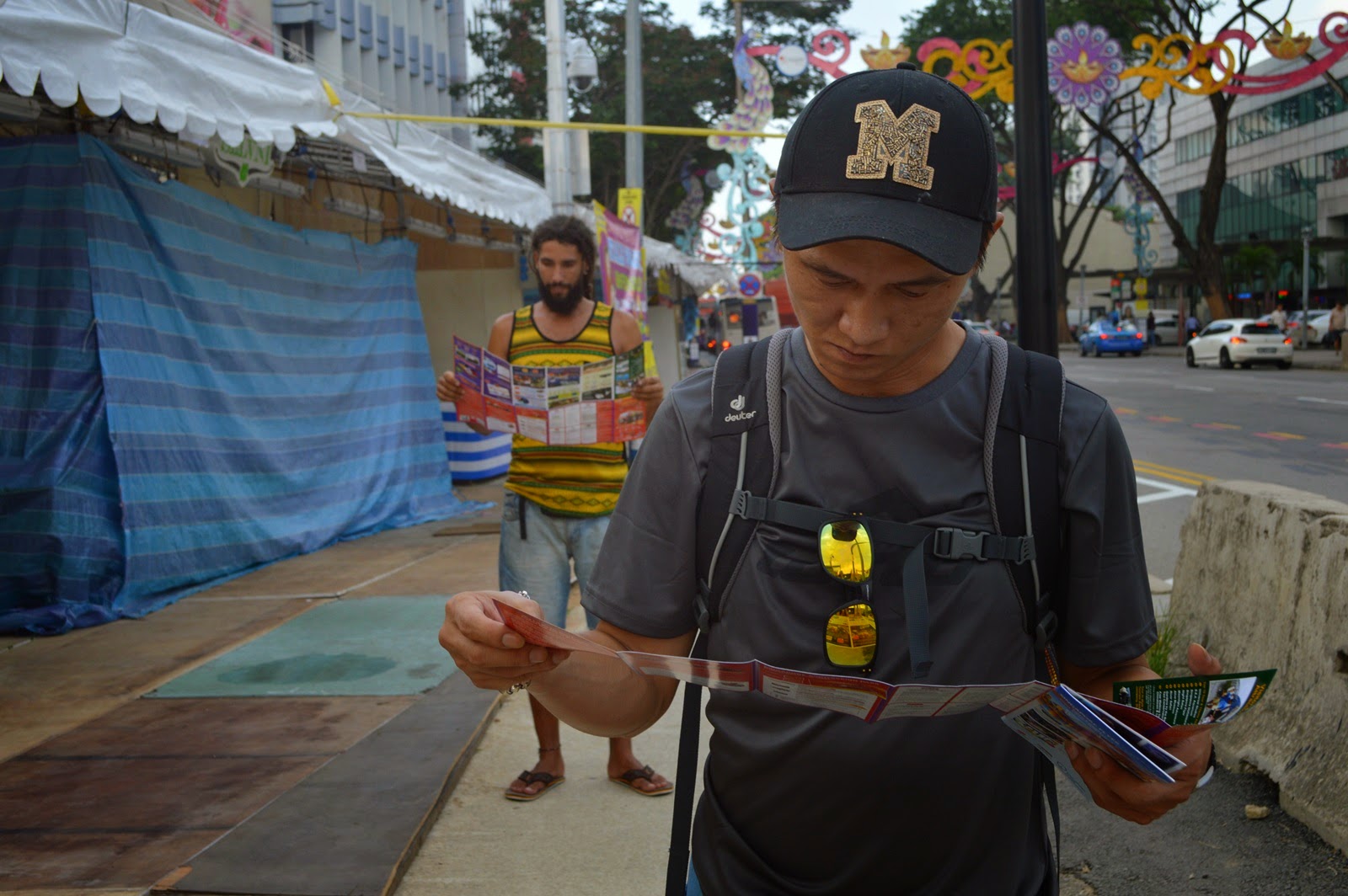La República de Singapur sería durante tres días testigo de nuestras aventuras. Es una Ciudad-Estado compuesta por infinidad de islas y considerada una de las "cuatro tigres asiáticas" por su importante industrialización y su poder económico, este territorio independiente fue en su época un importante enclave del Imperio Británico, como puesto comercial de la Compañía Británica de las Indias Orientales hasta su independencia en 1963, para luego formar parte de Malasia durante dos años hasta su expulsión en 1965, desde entonces este territorio no ha dejado de prosperar en lo que a economía se refiere, siendo a día de hoy el cuarto centro financiero del Mundo y el quinto puerto que mas mercancías mueve, es además el tercer país con mayor renta per cápita.
Es un país multicultural, donde se mezclan malayos, chinos, indios y euroasiáticos. La ciudad nos presenta variopintos sectores como Little India foco central de la comunidad india, el barrio Árabe, foco central de la comunidad musulmana o Chinatown centro neuralgico de la frenética actividad de la mayoritaria comunidad china. A parte de estas zonas bien diferenciadas la ciudad es en si, un centro financiero, lleno de centros comerciales, rascacielos y grandes y emblemáticos hoteles, entremezclados todos en una "megaurbe".
Singapur es una ciudad que nunca duerme, en constante ebullición, con un flujo constante de gente en el metro o en las calles.
Nosotros recorrimos este país de la manera mas económica que pudimos, observando y apreciando sus costumbres, muy occidentales por cierto y muy lejanas a lo que estábamos acostumbrados en Asia. Digamos que con un presupuesto bajo le sacamos el mayor jugo que pudimos a esta ciudad disfrutando de todo cuanto se puso a nuestro alcance.....
Singapur
means the City of the Lion. The tiny country consists of 63 islands,
the biggest of them is Singapore Island.
It
was a part of the Sumatran Srivijaya Empire and then belonged to the
Chola Empire. Afterwords- it formally was part of Johor Sultanate,
but after beeing burned by the portuguese, the place got almost
forgotten until in 1819 Thomas Stamford Raffles signed Singapore to
be British East India Companys trading post. Durind the II World War
the Japanese occupied the city. On 31 August 1963 Singapore, that by
the time was under the juridiction of British India, became
independent.
„The
country is the world's fourth leading financial
centre,
one
of the world's top three oil-refining centres, the world's largest
oil-rig producer, and a major hub for ship repair services.” It's
a very modern city, with skyscrappers, hi-tech present everywhere
and full of hip caffees and posh restaurants.
The
city is highly multicultural. Out of the 5,5 mln inhabitants, 70% of
them are of chinese origin, Malay, Indians and Europeans follow. The
four official languages of Singapore are English, Malay, Mandarin and
Tamil, which represents the four biggest ethnic groups.
A
walk around the city can easily turn into a travel between the
cultures: the modern and fnacy Marina for the wealthy, colourfull
Little India, climatic Arab Quarter nieghbouring with the Malay part
and thee cheap and always full of people Chinatown. Nature lovers can
do some free camping at the beach close to harbour and those looking
for some nice night-party-vibe can head to Clarks Quay.
Szorcik:
Singapur- miasto Lwa, położone jest na 63 wyspach. To państwo-
miasto było częściś wielu imperiów: sumatryjskiego Srivijaya,
następnie Chola. Będąc pod oficjalnym władaniem Sułtanatu Johor
miasto mocno podupadło, w czym udział swój mieli Portugalczycy,
którzy je spalili. W 1819r Thomas Stamford Raffles podpisał z
Sułtanem umowę czyniącą z Singapuru ośrodek handlowy Brytyjskiej
Kompanii Wschodnioindyjskiej. Podczas II Wojny Światowej terytorium
Singapuru okupowane było przez Japonię. Od 31. sierpnia 1963
Singapur odzyskał niepodległość od Imperium Brytyjskiego i
stanowi niezależne państwo.
W
ciągu niewielu lat Singapur stał się ekonomicznym gigantem, jednym
z 4 Azjatyckich Tygrysów, potęgą w przetwórswie ropy oraz ważnym
miastem portowym i stoczniowym.
Ultranowoczesne
centrum pełne jest nowatorskich technologicznych rozwiązań, jest
tu czysto, a dziesiątki drapaczy chmur dodają miastu nowoczesnego
charakteru.
Singapur
jest miejscem multikulturowym, spośród 5,5mln mieszkańców
większość stanowią osoby pochodzenia chińskiego, co
niekoniecznie oznacza przybyłych tu bezpośrednio z Chin (duża
część to Chińczycy pochodzący z Malezji). Za Chińczykami
plasuja się Malajowie, Hindusi oraz Europejczycy. Oficjalnymi
językami są Angielski, Mandaryński, Malajski oraz Tamilski, choć
na ulicach usłyszeć można o wiele szerszą mieszankę.
Na
tym małym terenie można przemieszczać się w czasie, między
kulturami i cywilizacjami. Marina to nowoczesność, eleganckie
restauracje i drogie kawiarnie i jachtkluby, popularne wśród
bogatych mieszkańców. Reszta miasta dzieli się między innymi a
Malajską dzielnicę, która łaczy się z bardzo klimatyczną
dzielnicą muzułmańską. Little India to feria kolorów i
orientalnych smaków a Chinatown to tanie targowisko i miejsce
spotkań na partyjkę chińskich szachów przy piwie na małych,
zaludnionych placykach. Chcąc odetchnąć od zgiełku miasta, można
się udać do jednego z parków lub po prostu rozbić darmowo namiot
na plaży niedaleko portu. Nocne życie kręci się wokół kanału
na Clarks Quay.


































No hay comentarios:
Publicar un comentario